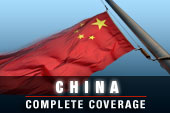Chinese exporters had a whacking great December, posting a year-to-year gain of 14.1 percent and giving China its first annual trade surplus in four years. The U.S. trade deficit grew by 15.8 percent in November, led primarily by imports of iPhones and other electronic gadgets.

What’s not to like, you ask. The Chinese economy is on the rebound; gross domestic product may reach the magical growth rate of 8 percent, which was thought beyond reach only last autumn. The U.S. trade stats suggest that American consumers are shopping again—a welcome sign that our frail recovery may be gaining some heft.
Continue on this path and the U.S. and China—leaving Europe out of this for now—may well emerge this year into a post-crisis phase of steady, sustainable growth. But neither nation will have done anything at all in the way of urgently needed structural reforms. It is the phenomenon of change amid no change, or no change amid change, take your pick.
Look at the mainland. After a miserable November, the monthly trade surplus bounced from $19.6 billion to $31.6 billion. For 2012 as a whole, the merchandise surplus was $231 billion, according to Beijing’s statistics, more than double last year’s numbers. What is more, the fastest-growing market for Chinese goods is now Southeast Asia, reflecting Beijing’s intention to diversify into emerging markets and away from advanced industrial nations. Exports to Southeast Asia grew by 20 percent in 2012.
Grind these numbers down to talcum powder and China’s growth in Southeast Asia, is from a very small base—even now it is only 10 percent of China’s total exports. The U.S. accounts for not quite twice that proportion, and its imports from China bounced 10.3 percent in December. The latter is a vastly more meaningful figure.
Mainland economists are pleased. They are relieved to report the return of upward momentum in the Chinese economy, primarily from the external sector.
But this makes plain that China is only the slightest trifle less dependent on exports than it was when it disclosed its latest five-year plan—a document issued in 2010 and promising a major shift away from exports and toward wage growth, domestic consumption, and investment. My bet: It may never get there, because Chinese citizens (if we get to call them that) are too politically restive and the leadership is spooked.
I see little to cheer for in any of this (apart from those Chinese who are politically resistant). Short-term gains can take delude some into thinking that China’s economy is on the rebound. A recovery of the sort China now appears to bank upon will put us in a perfect position to step back and wait for the next inflationary bubble, slump, and recession.
It is the same in the U.S., one must quickly add. Last year’s trade deficit (we do not have December numbers yet) looks as if it will land at around $545 billion, a smidge down from 2011. Economists are saying that higher imports—they rose by 3.8 percent in November—signal strengthening domestic consumption and business investment. This, they add, will outweigh that chronic overall deficit. In other words, take your eyes off the sluggish, 1 percent increase in exports.
I am not buying. What accounted for the rise in imports? Consumer electronics, which accounted for a fifth of all imports and rose to a record. That is not business investment. What about the deficit with China? Oh, that. It was $29 billion in November, down a touch from October’s $29.5 billion, which was an all-time record.
It has been five years now. America should be emerging into post-crisis growth a different kind of nation. It is hard to believe, but as recently as the early 1990s the U.S. savings rate
hovered just below 8 percent. Now it is less than half that and falling. Consumer spendinghttp://www.reuters.com/article/2012/10/29/usa-economy-spending-idUSL1E8L... accounts for 70 percent of American economic activity. This is a picture-in-numbers of a disgracefully skewed economy.
Maybe neoliberal America and Communist China are ironically made for one another. The one cannot get off its consumer-goods addiction and begin to save and invest, and the other cannot stop investing in export industries because it is politically tippy. Everyone knows that when times are good nothing special gets done on the economic-policy side. These past few years were an opportunity in this respect—a missed opportunity, it now begins to seem—to put some needed reforms into place on both sides of the Pacific.






